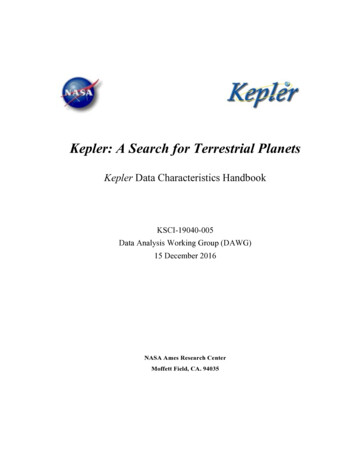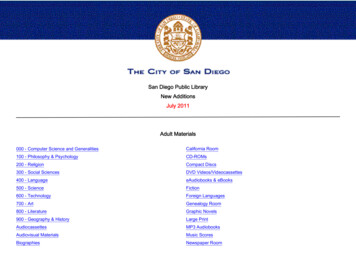
Transcription
Kepler: A Search for Terrestrial PlanetsKepler Data Characteristics HandbookKSCI-19040-005Data Analysis Working Group (DAWG)15 December 2016NASA Ames Research CenterMoffett Field, CA. 94035
KSCI-19040-005: Kepler Data Characteristics Handbook212/15/2016
KSCI-19040-005: Kepler Data Characteristics Handbook12/15/2016DOCUMENT CHANGE LOGFrom on by name and year not by numberModernize references where necessaryRemove forward-looking statementsMake less admonitory1.1Extend to end of mission with uniform formatting1.21.31.43.14.64.74.85.115.11Extend to end of mission and clarify meaning of FFI time stampModernize major document listUpdateReplace with CDPP tracking plot from DRN 25; update scatter plot; update Table 4post-Kepler mod 7 failure5.115.125.1766.36.4911Wheel 4 failure, restThis problem has been correctedPreamble about MAP for SCGenerate similar figure for Q5 data and assess stability of spurious signal over mission.Check internal consistency of table, reference Baran, correct first line. Make unitsconsistent (uHz)Tidy formatAdded new section for fixed bugs in SC pipeline processingRemove forward statements about reprocessing Q0-Q14 for correct timeNo longer neededTidy up. Remove cautions and forward-looking statementsPASP style, check and clean up referencesSOC Pipeline history appendix removed in favor of recent KDRNs and KDPH3
KSCI-19040-005: Kepler Data Characteristics Handbook12/15/2016The Data Characteristics Handbook is the collective effort of the Data Analysis Working Group(DAWG), which is composed of Science Office (SO), Science Operations Center (SOC), and GuestObserver (GO) Office members as listed below:Jon Jenkins, ChairDoug Caldwell, Co-ChairBarclay, ThomasBryson, Stephen T.Burke, Christopher J.Campbell, JenniferCatanzarite, JosephChristiansen, Jessie L.Clarke, Bruce D.Coughlin, Jeffrey L.Girouard, ForrestHaas, Michael R.Klaus, ToddKolodziejczak, Jeffery (MSFC)Li, JieMcCauliff, Sean D.Morris, Robert L.Mullally, FergalQuintana, Elisa V.Rowe, JasonSabale, AnimaSeader, ShawnSmith, Jeffrey ClaiborneStill, Martin D.Tenenbaum, Peter G.Thompson, Susan E.Twicken, JoeUddin, Akm KamalVan Cleve, Jeffrey E.Zamudio, KhadeejahWhen citing this document, please use the following reference:J. E. Van Cleve, J. L. Christiansen, J. M. Jenkins, D. A. Caldwell, T. Barclay, S. T. Bryson, C. J.Burke, J. Campbell, J. Catanzarite, B. D. Clarke, J. L. Coughlin, F. Girouard, M. R. Haas, T. C.Klaus, J. J. Kolodziejczak, J. Li, S. D. McCauliff, R. L. Morris, F. Mullally, E. V. Quintana, J.Rowe, A. Sabale, S. Seader, J. C. Smith, M. D. Still, P. G. Tenenbaum, S. E. Thompson, J. D.Twicken, A. K. Uddin, and K. Zamudio, 2016, Kepler Data Characteristics Handbook (KSCI-19040005).4
KSCI-19040-005: Kepler Data Characteristics Handbook12/15/2016Document ControlOwnershipThis document is part of the Kepler Project Documentation that is controlled by theKepler Project Office, NASA/Ames Research Center, Moffett Field, California.Control LevelThis document will be controlled under KPO @ Ames Configuration Managementsystem. Changes to this document shall be controlled.Physical LocationThe physical location of this document will be in the KPO @ Ames Data Center.Distribution RequestsTo be placed on the distribution list for additional revisions of this document, pleaseaddress your request to the Kepler Science Office:Michael R. HaasKepler Science Office Director MS 244-30NASA Ames Research CenterMoffett Field, CA 94035-1000Michael.R.Haas@nasa.gov5
KSCI-19040-005: Kepler Data Characteristics Handbook12/15/2016Table of Contents1.Introduction . 91.1Dates, Cadence Numbers, and Units . 101.2Full Frame Images . 131.3Document Overview . 142.Release Description . 153.Evaluation of Performance . 163.1Overall . 164.Historical Events . 194.1Kepler Mission Timeline To Date . 194.2Safe Mode . 194.3Loss of Fine Point . 204.4Attitude Tweaks Every Few Days . 204.5Variable FGS Guide Stars . 214.6Module 3 Failure . 224.7Reaction Wheel Failures. 234.8CH Cyg Corrupts the Smear Correction . 235.Ongoing Phenomena . 255.1Image Motion . 255.2Focus Changes . 265.3Momentum Desaturation . 295.4Reaction Wheel Zero Crossings . 295.5Downlink Earth Point . 315.6Manually Excluded Cadences . 315.7Incomplete Apertures Produce Discontinuities at Quarter Boundaries . 315.8Argabrightening . 325.9Pixel Sensitivity Dropouts . 335.10Short Cadence Requantization Gaps . 345.11Spurious Frequencies in SC Data . 355.12Propagation of Uncertainties . 385.13Onboard Spacecraft Errors . 395.14Coronal Mass Ejections - Data Loss and Detector Changes . 396
KSCI-19040-005: Kepler Data Characteristics Handbook12/15/20165.15Attenuation of Long Period Signals . 405.16Anomaly Summary Figure . 415.17 Fixed Bugs in SC Pipeline Processing . 436.Time and Time Stamps. 446.1Overview . 446.2Time Transformations, VTC to BKJD . 446.3Absolute Timing Accuracy with Kepler. 467.Ensemble Cotrending Basis Vectors . 487.1Introduction . 487.2Generation of CBVs . 487.3Using CBVs . 497.4Cautions . 507.5Obtaining CBVs . 508.Contents of Supplement . 519.References . 5210.List of Acronyms and Abbreviations . 537
KSCI-19040-005: Kepler Data Characteristics Handbook12/15/2016PrefaceThe Kepler Data Processing Pipeline was developed for automated photometry of over 160,000 stars, andthus has always had to balance the Benthamite goal of doing the greatest good for the greatest numberagainst the hazard of signal distortion for a particular target. In its final version, the pipeline used themulti-scale Bayesian Maximum A Priori (msMAP) method of systematic error removal, which producedsignificantly improved results for most long cadence targets compared to the pipeline version availablesoon after launch in 2009 (see papers by Smith et al. 2012 and Stumpe et al. 2012, 2014). Since eventhis final version of the pipeline may not be optimal for a particular target or science purpose, Kepler alsoprovides target pixel files so that users can perform their own photometry. In addition, Kepler providescotrending basis vectors (see §7.0) for all quarters so that users can better remove systematics from lightcurves generated by the pipeline or by themselves from target pixel files, while weighing the tradebetween systematic noise removal and signal fidelity given their target characteristics and science goals.Investigators are strongly encouraged to study the Kepler Data Characteristics Handbook (KDCH) andData Release Notes (DRNs) for all data sets that they intend to use; these documents in turn often referto the Kepler Instrument Handbook (KIH) for basic information about the construction and operation ofthe Kepler flight system. We advise against publication of results based on Kepler light curves withoutsuch careful consideration and due diligence by the end user, and dialogue with the Science Office orGuest Observer Office where appropriate.Users are encouraged to notice and document artifacts or issues with the processing and report them tothe Kepler Science Office at ine8.0andlaterversionswillshowusmoreofthelight- rdstonavigationaroundtheedges.Far- ware.html8
KSCI-19040-005: Kepler Data Characteristics Handbook12/15/20161. IntroductionThe Kepler Data Characteristics Handbook (KDCH) provides a description of all phenomenaidentified in the Kepler data throughout the mission, and an explanation for how thesecharacteristics are handled by the final version of the Kepler Data Processing Pipeline (SOC 9.3).The KDCH complements the Kepler Data Release Notes (KDRNs), which document phenomenaand processing unique to a data release. The original motivation for this separation into static,explanatory text and a more “journalistic” set of figures and tables in the KDRN was for the user tobecome familiar with the Data Characteristics Handbook, then peruse the short Notes for a newquarter, referring back to the Handbook when necessary. With the completion of the Keplermission and the final Data Release 25, both the KDCH and the DRN encompass the entire Keplermission, so the distinction between them is in the level of exposition, not the extent of the timeinterval discussed.In addition to the Data Characteristics Handbook, the following documents are important forusers of Kepler data. All but items 5 and 6 are athttp://archive.stsci.edu/Kepler/documents.html1. Kepler Data Processing Handbook (KSCI-19081) or KDPH (Jenkins et al., 2017). TheKDPH describes how pixels downlinked from the spacecraft are converted by the KeplerData Processing Pipeline (henceforth just “the pipeline”) into the data products deliveredto the MAST archive. The KDPH is under revision for the final Kepler pipeline release(Jenkins et al., 2017). Refer to Part II of the KDPH for the definitive reference onpipeline processes such as black level estimation (Dynamic Black Correction), pixellevel calibration (CAL), light curve extraction (Photometric Analysis, PA), optimalaperture calculation (PA-COA), and systematic error correction (Presearch DataConditioning, PDC).2. Kepler Archive Manual (KDMC-10008) or KAM (Thompson et al., 2016). The KAMdescribes the format and content of the data products, and how to search for them.3. Kepler Instrument Handbook (KSCI-19033) or KIH (Van Cleve and Caldwell, 2016),which provides information about the design, performance, and operational constraints ofthe instrument, and an overview of the types of pixel data that are available. Users willneed to be familiar with the material in Sections 2 and 4.2-4.5 of the KIH to fully benefitfrom this document and the accompanying Notes.4. The Kepler Data Release Notes (KDRNs) document the specific instances of thephenomena described in the remainder of this document for each release of data.5. The Kepler Mission Special Issue of Astrophysical Journal Letters (Volume 713, Number2, 2010 April 20) contains papers providing background on mission definition (Koch, et al.2010), target selection (Batalha, et al. 2010), science operations (Haas et al. 2010), theKepler point spread function (Bryson, et al. 2010), instrument performance (Caldwell et al.2010), and the data processing pipeline (Jenkins et al. 2010a). Two papers discuss thecharacteristics of the Long Cadence (Jenkins et al. 2010b) and Short Cadence data(Gilliland et al. 2010), respectively. Numerous additional papers also provide early scienceresults in both planet detection and asteroseismology, placing the use of Kepler data incontext.6. Papers describing important post-launch improvements to the pipeline, includingdescriptions of the calibration of the pixels in CAL (Quintana et al. 2010), aperturephotometry in PA (Twicken et al. 2010), light curve conditioning and systematic errorremoval in PDC (Smith et al. 2012; Stumpe et al. 2012 and 2014), and optimal aperturecalculation in PA-COA (Smith et al. 2016).9
KSCI-19040-005: Kepler Data Characteristics Handbook12/15/2016The KDCH will from time to time compare the characteristics of the ultimate (DR 25) to the thoseof the penultimate (DR 24) release to illustrate the benefits of pipeline improvements, but is notmeant to be a running historical narrative of all pipeline processing or errors found and fixed. Forusers interested in the provenance and characteristics of earlier releases used for already-publishedscientific papers, earlier versions of this document and the relevant KDRNs are available atMAST.The Kepler mission was reconstituted as the K2 mission after the failure of the 2nd of Kepler’s 4reaction wheels in May 2013 (Howell et al., 2014; Van Cleve et al., 2016). The characteristics ofthe K2 data, while remaining superior to the best ground-based photometry, are sufficientlydifferent from those of Kepler data to warrant a separate document. No further revisions of theKDCH are planned, as both data collection and processing have concluded for Kepler.1.1Dates, Cadence Numbers, and UnitsA set of coadded and stored pixels obtained at a specific time is referred to as a cadence, and thetotal amount of time over which the data in a cadence is coadded is the cadence period. The twocadence periods in use are Long Cadence (LC) and Short Cadence (SC). Each cadence consists of aseries of frames that each include a 6.02 s exposure time and a 0.52-s readout time. For LongCadence and Full Frame Images (FFI), 270 frames are coadded, for a total of 1765.5 s 0.4904 h.For Short Cadence, 9 frames are coadded, for a total of 58.85 s. Cadences are absolutely anduniquely enumerated with cadence interval numbers (CIN), which increment even when nocadences are being collected, such as during downlinks and safe modes. The relative cadence index(RCI) is the cadence number counted from the beginning of a quarter (LC) or month (SC), and alsoincrements even when no cadences are being collected. RCIs are calculated from the first validCadence of a Quarter (LC) or Month (SC). For example, the first LC of Q1 has an RCI 1 andCIN 1105, while the last LC of Q1 has RCI 1639 and CIN 2743. A list of the cadencesassociated with each quarter of data is given below. Times have been rounded to the nearestsecond.Table 1. Long Cadence DataQFirstLast CadenceCadence MJDMJDmidTimemidTimeFirst CadenceUTmidTimeLast CadenceUTmidTime2-May-2009 00:54:5611-May-2009 744114765681043154964.0109954997.4812213-May-2009 00:15:50 15-Jun-2009 2009 00:25:10 16-Sep-2009 2009 17:19:59 16-Dec-2009 -2009 21:03:56 19-Mar-2010 r-2010 23:47:16 23-Jun-2010 n-2010 22:44:09 22-Sep-2010 p-2010 16:08:24 22-Dec-2010 55092988314-Mar-2011 20:18:163279306573393555738.4239521-Mar-2011 00:24:25 26-Jun-2011 -2011 08:14:33 28-Sep-2011 ep-2011 16:56:204-Jan-2012 n-2012 21:49:5528-Mar-2012 ar-2012 05:42:32 27-Jun-2012 un-2012 15:17:48475757024617806-Jan-2011 20:45:09103-Oct-2012 19:40:11
KSCI-19040-005: Kepler Data Characteristics HandbookQFirstLast CadenceCadence MJDMJDmidTimemidTime12/15/2016First CadenceUTmidTimeLast 55056303.637685-Oct-2012 23:39:0711-Jan-2013 an-2013 14:21:118-Apr-2013 r-2013 17:26:4511-May-2013 12:01:4015567097672531StartCINEndCINTable 2. Short Cadence 953.02828154964.001122.12.2First CadenceUTmidTimeLast CadenceUTmidTimeNumberCINs54962.753992-May-2009 00:40:4311-May-2009 18:05:451428055001977954997.4911013-May-2009 00:01:3715-Jun-2009 n-2009 00:10:5720-Jul-2009 ul-2009 19:42:5419-Aug-2009 20-Aug-2009 20:38:3216-Sep-2009 18-Sep-2009 17:05:4619-Oct-2009 19-Oct-2009 21:56:4718-Nov-2009 21-Nov-2009 00:22:3017-Dec-2009 19-Dec-2009 20:49:4319-Jan-2010 20-Jan-2010 19:20:0218-Feb-2010 18-Feb-2010 19:13:1419-Mar-2010 20-Mar-2010 23:33:0221-Apr-2010 22-Apr-2010 18:39:1020-May-2010 21-May-2010 02:21:2323-Jun-2010 24-Jun-2010 22:29:5622-Jul-2010 22-Jul-2010 20:53:0422-Aug-2010 23-Aug-2010 16:26:4922-Sep-2010 23-Sep-2010 15:54:1123-Oct-2010 24-Oct-2010 12:54:2622-Nov-2010 23-Nov-2010 14:47:0922-Dec-2010 6-Jan-2011 20:30:5524-Jan-2011 24-Jan-2011 14:40:4322-Feb-2011 22-Feb-2011 18:29:1814-Mar-2011 921-Mar-2011 00:10:1226-Apr-2011 10:03:29534601015570 10690299.255678.1145155706.6187127-Apr-2011 02:44:5425-May-2011 14:50:56418501070050 11118999.355707.2528355738.4338326-May-2011 06:04:0526-Jun-2011 10:24:43457801112830 115860910.1 55739.3335655769.4520127-Jun-2011 08:00:1927-Jul-2011 10:50:54442201159930 120414910.2 55770.2904755801.7371028-Jul-2011 06:58:1628-Aug-2011 17:41:26461701205380 125154910.3 55802.5755655832.7757529-Aug-2011 13:48:4928-Sep-2011 18:37:05443401252780 129711911.1 55833.6959155864.7747429-Sep-2011 16:42:0730-Oct-2011 18:35:38456301298470 134409911.2 55865.5314755895.7316531-Oct-2011 12:45:1930-Nov-2011 17:33:35443401345210 138954911.3 55896.6109855930.836561-Dec-2011 14:39:494-Jan-2012 20:04:39502501390840 144108912.1 55931.8997855958.401495-Jan-2012 21:35:411-Feb-2012 09:38:09389101442650 148155912.2 55959.1173555986.497702-Feb-2012 02:48:5929-Feb-2012 11:56:41402001482610 152280912.3 55987.3974656014.532601-Mar-2012 09:32:2028-Mar-2012 12:46:57398401524130 156396913.1 56015.2279956047.4919829-Mar-2012 05:28:1930-Apr-2012 11:48:27473701564990 1612359Q.m11
KSCI-19040-005: Kepler Data Characteristics Time12/15/2016First CadenceUTmidTimeLast CadenceUTmidTimeNumberCINsStartCINEndCIN13.2 56048.1874056077.427211-May-2012 04:29:5130-May-2012 10:15:11429301613380 165630913.3 56078.3269756105.5642831-May-2012 07:50:5027-Jun-2012 13:32:34399901657630 169761914.1 56106.6274856123.5049528-Jun-2012 15:03:3415-Jul-2012 12:07:07247801699180 172395914.2 56138.6469356168.8062530-Jul-2012 15:31:3529-Aug-2012 19:21:00442801746190 179046914.3 56169.6651456203.8294430-Aug-2012 15:57:483-Oct-2012 19:54:24501601791730 184188915.1 56205.9756256236.809255-Oct-2012 23:24:545-Nov-2012 19:25:19452701845040 189030915.2 56237.7703156267.888756-Nov-2012 18:29:156-Dec-2012 21:19:48442201891720 193593915.3 56268.7272156303.647567-Dec-2012 17:27:1111-Jan-2013 15:32:29512701937170 198843916.1 56304.5881756309.8184912-Jan-2013 14:06:5817-Jan-2013 19:38:3776801989820 199749916.2 56321.1598156357.4696529-Jan-2013 03:50:086-Mar-2013 11:16:18533102014150 206745916.3 56358.6146156390.469927-Mar-2013 14:45:038-Apr-2013 11:16:41467702069140 211590917.1 56391.7170356414.091149-Apr-2013 17:12:312-May-2013 02:11:15328502117740 215058917.2 56419.3023956423.511037-May-2013 07:15:2611-May-2013 12:15:5361802158240 2164419Table 3. Full Frame ImagesQFilenameUT StartUT End0KPLR200911417483324-Apr-2009 17:19:0824-Apr-2009 17:49:330KPLR200911420483524-Apr-2009 20:19:1024-Apr-2009 20:48:350KPLR200911500261324-Apr-2009 23:56:4825-Apr-2009 00:26:130KPLR200911505361625-Apr-2009 05:06:5125-Apr-2009 05:36:160KPLR200911508062025-Apr-2009 07:36:5525-Apr-2009 08:06:200KPLR200911513112225-Apr-2009 12:41:5625-Apr-2009 13:11:220KPLR200911517361125-Apr-2009 17:06:4625-Apr-2009 17:36:110KPLR200911603592425-Apr-2009 03:29:5826-Apr-2009 03:59:242KPLR200917004391519-Jun-2009 04:09:4919-Jun-2009 04:39:152KPLR200923119483119-Aug-2009 19:19:0519-Aug-2009 19:48:312KPLR200926000080016-Sep-2009 23:38:3417-Sep-2009 00:08:003KPLR200929202042919-Oct-2009 01:35:0419-Oct-2009 02:04:293KPLR200932223304718-Nov-2009 23:01:2118-Nov-2009 23:30:473KPLR200935100524517-Dec-2009 00:23:1917-Dec-2009 00:52:454KPLR201001922550219-Jan-2010 22:25:3719-Jan-2010 22:55:024KPLR201002000504620-Jan-2010 00:21:2120-Jan-2010 00:50:464KPLR201004918230218-Feb-2010 17:53:3718-Feb-2010 18:23:024KPLR201007817452419-Mar-2010 17:15:5819-Mar-2010 17:45:245KPLR201011112502621-Apr-2010 12:21:0121-Apr-2010 12:50:265KPLR201014010163120-May-2010 09:47:0620-Mar-2010 10:16:315KPLR201017416411323-Jun-2010 16:11:4823-Jun-2010 16:41:136KPLR201020301221522-Jul-2010 00:52:4922-Jul-2010 01:22:156KPLR201023419274522-Aug-2010 18:58:1922-Aug-2010 19:27:456KPLR201026519535622-Sep-2010 19:24:3122-Sep-2010 19:53:567KPLR201029619211923-Oct-2010 18:51:5323-Oct-2010 19:21:197KPLR201032618172822-Nov-2010 17:48:0322-Nov-2010 18:17:287KPLR201035602012822-Dec-2010 01:32:0322-Dec-2010 02:01:288KPLR201102413492624-Jan-2011 13:20:0124-Jan-2010 13:49:2612
KSCI-19040-005: Kepler Data Characteristics Handbook12/15/2016QFilenameUT StartUT End8KPLR201105317440122-Feb-2011 17:14:3522-Feb-2011 17:44:019KPLR201111610400226-Apr-2011 10:10:3726-Apr-2011 10:40:029KPLR201114515272325-May-2011 14:57:5825-Mar-2011 15:27:239KPLR201117711011026-Jun-2011 10:31:4426-Jun-2011 11:01:1010KPLR201120811272727-Jul-2011 10:58:0127-Jul-2011 11:27:2710KPLR201124018175228-Aug-2011 17:48:2728-Aug-2011 18:17:5210KPLR201127119133128-Sep-2011 18:44:0628-Sep-2011 19:13:3111KPLR201130319121130-Oct-2011 18:42:4530-Oct-2011 19:12:1111KPLR201133418100830-Nov-2011 17:40:4330-Nov-3011 18:10:0811KPLR201200420411204-Jan-2012 20:11:4704-Jan-2012 20:41:1212KPLR201203210144201-Feb-2012 09:45:1601-Feb-2012 10:14:4212KPLR201206012330829-Feb-2012 12:03:4229-Feb-2012 12:33:0812KPLR201208813232428-Mar-2012 12:53:5828-Mar-2012 13:23:2413KPLR201212112250030-Apr-2012 11:55:3030-Apr-2012 12:25:0013KPLR201215110513830-May-2012 10:22:1230-May-2012 10:51:3813KPLR201217914090127-Jun-2012 13:39:3527-Jun-2012 14:09:0114KPLR201221112392329-Jul-2012 12:09:5829-Jul-2012 12:39:2314KPLR201224219572629-Aug-2012 19:28:0129-Aug-2012 19:57:2614KPLR201227720305130-Oct-2012 20:01:2530-Oct-2012 20:30:5115KPLR201231020015205-Nov-2012 19:32:2705-Nov-2012 20:01:5315KPLR201234121562106-Dec-2012 21:26:5606-Dec-2012 21:56:2215KPLR201301116090211-Jan-2013 15:39:3711-Jan-2013 16:09:0316KPLR201303813313007-Feb-2013 13:02:0507-Feb-2013 13:31:3016KPLR201306511525106-Mar-2013 11:23:2606-Mar-2013 11:52:5116KPLR201309811530808-Apr-2013 11:23:4308-Apr-2013 11:53:08Figures and tables in this document and the KDRN present results in CIN, RCI, or ModifiedJulian Date (MJD), since MJD is the preferred time base of the Flight System and pipeline, andcan be mapped one-to-one onto CIN or RCI. On the other hand, the preferred time base forscientific results is Barycentric Julian Date (BJD); the correction to BJD, as described in detail in§6.2.4, is done on a target-by-target basis in the files available from MAST. The MJD of acadence refers to the time at the midpoint of the cadence.As of July 2011, details of which cadences are affected by most of the phenomena described inthis document are available in the light curve and target pixel FITS files themselves, availablefrom MAST. However, some processing details remain in the Data Release Notes, so users areencouraged to check these documents as well.1.2Full Frame ImagesThe FFIs contain a non-linear World Coordinate System (WCS) using the simple imagingpolynomial (SIP) conventions of Shupe et al. (2005). The WCS solution is calculated from themotion polynomials based on the quarterly long cadence processing. Prior to DR 24, the pipelinedid not calculate a motion polynomial directly from the FFI, but instead used the solution from thenearest LC. The WCS solution is typically accurate to 0.1 pixels (0.4 arcseconds) when comparedto the 2MASS point source catalogue (Skrutskie et al. 2006). For additional details, see the ArchiveManual.The first 8 “golden” FFIs (Q0) and the first FFI of Q2 were not associated with a valid target table13
KSCI-19040-005: Kepler Data Characteristics Handbook12/15/2016and were not reprocessed in DR 24 or 25, and hence will have lower accuracy than typical of theother FFIs. The first FFI of Q2 is furthermore degraded since this FFI was taken at the very start ofthe quarter and we entered a safe mode shortly thereafter. When we subsequently returned tonormal operation the pointing was offset from the pointing when the FFI was taken. We have useda linear solution for the WCS for this FFI and only expect the WCS to be accurate to 1 pixel forCCDs near the edges of the focal plane.The FFI time stamps are barycenter-corrected times corresponding to the middle of each outputchannel (§6).1.3Document OverviewIn §2, we describe the generation and contents of a data release. Our evaluation of the currentprecision of the data is outlined in §3. A description of the historical events that have affected theKepler data is provided in §4; similarly a description of the ongoing phenomena affecting the datais provided in §5. §6 outlines the generation and precision of the time stamps associated withKepler data. §7 describes the ensemble Cotrending Basis Vectors for use in cotrending flux timeseries. §8 details the obsolescence of the Data Release Notes Supplement. A list of references isincluded in §9, and the acronyms used throughout this and other Kepler documents are defined in§10. See th
The physical location of this document will be in the KPO @ Ames Data Center. Distribution Requests To be placed on the distribution list for additional revisions of this document, please address your request to the Kepler Science Office: Michael R. Haas Kepler Science Office Director MS 244-30 NASA Ames Research Center










